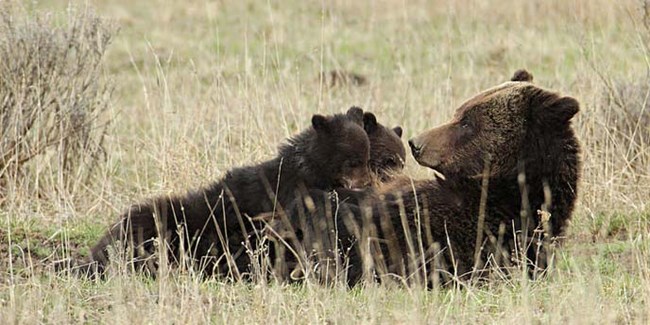
Frank T. van Manen, Cecily M. Costello, Kerry A. Gunther, & Mark A. Haroldson
From Yellowstone Science 23(2): Pages 4-6.
Because of its large size, remoteness, and the protections afforded by national park, national forest, and national wildlife refuge lands over a large portion of the area, the GYE grizzly bear population was the only one of the three isolated populations that persisted in viable numbers after the 1960s (Cowan et al. 1974). During the following decade, biologists estimated as few as 600–800 grizzly bears remained in the lower 48 states. In 1975, grizzly bears in the lower 48 states, including the GYE, were listed by the U.S. Fish and Wildlife Service (USFWS) as a threatened species under the Endangered Species Act. In 1983, the Interagency Grizzly Bear Committee was formed to help ensure grizzly bear recovery through interagency coordination of policy, planning, management, and research. The federal, state, and tribal members of this committee, as well as its Yellowstone Ecosystem Subcommittee, initiated various measures to protect vital habitat and reduce bear mortality in the GYE (see Yellowstone Science, 2008:16[2]). These measures were associated with higher survival, a steady increase in the bear population, expansion of bear range, and recolonization of previously occupied habitats. By the end of the 20th century, the USFWS and these committees determined that the population had recovered and should be moved toward delisting. One of the tasks in the 1993 Recovery Plan (USFWS 1993) was the preparation of a Conservation Strategy, detailing management and monitoring plans for if and when the population was delisted. A final plan was released in 2007 (USFWS 2007a); and the USFWS submitted a final rule to delist the Yellowstone grizzly bear population in March 2007 (USFWS 2007b), effectively removing the population from the Endangered Species List. This delisting rule was challenged by a number of conservation organizations and the Federal District Court in Missoula, Montana issued an order vacating the delisting in September 2009. Protections as a threatened population under the Endangered Species Act were reinstated in March 2010. The USFWS appealed the District Court decision on the primary grounds that: 1) regulatory mechanisms after delisting (i.e., the Conservation Strategy) were adequate to ensure the grizzly population would not decline;and 2) the potential loss of whitebark pine (Pinus albicaulis) as a food source would not threaten the GYE grizzly bear population. The 9th Circuit Court of Appeals rendered a decision in November 2011 and reversed the District Court decision regarding the adequacy of protections provided under the Conservation Strategy, but upheld the District Court decision that the USFWS had not sufficiently demonstrated the whitebark pine decline was not a threat to the Yellowstone grizzly bear population. In response to this court decision, the Interagency Grizzly Bear Committee and its Yellowstone Ecosystem Subcommittee tasked the Interagency Grizzly Bear Study Team with conducting a comprehensive assessment of the current state of knowledge regarding whitebark pine decline and responses of grizzly bears to changing food resources in the GYE. This research became particularly relevant given the increasing population trajectory documented at the time. In this issue, we report on the results from several interesting grizzly bear research projects conducted in the GYE, including demographic changes, cub adoption among related mother bears, unique bear scent-marking behavior at a small remote pond, the numeric probability of being attacked by a grizzly bear when backpacking, results of a pilot project using new camera collar technology, and the challenges of managing habituated grizzly bears in the face of increasing visitation in national parks. In addition, we take a look back at some unusual attempts at modifying nuisance bear behavior during the early history of Yellowstone National Park. Literature Cited Cowan, I.M., D.G. Chapman, R.S. Hoffmann, D.R. McCullough, G.A. Swanson, and R.B. Weeden. 1974. Report of the committee on the Yellowstone grizzlies. National Academy of Sciences, Washington, D.C., USA.
Servheen, C. 1999. Status and management of the grizzly bear in the lower 48 United States. Pages 50–54 in C. Servheen, S. Herrero, and B. Peyton, editors. Bears: Status survey and conservation action plan.
IUCN/SSC Bear and Polar Bear Specialist Groups, IUCN, Gland Switzerland and Cambridge, UK. U.S. Fish and Wildlife Service. 1993. Grizzly bear recovery plan. U.S. Fish and Wildlife Service, Missoula, Montana, USA. U.S. Fish and Wildlife Service. 2007a. Final conservation strategy for the grizzly bear in the Greater Yellowstone Area. U.S. Fish and Wildlife Service, Missoula, Montana, USA. U.S. Fish and Wildlife Service. 2007b. Final rule designating the GYA population of grizzly bears as a distinct population segment and removing the Yellowstone distinct population segment of grizzly bears from the federal list of endangered and threatened wildlife. 72 FR 14866. |
Last updated: December 21, 2015
